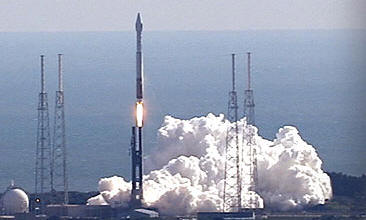
| NEWSROOM |
|
|
 |
|
|
|
|
|
|||
|
By Mike Mitchell |
||||
 |
February 12, 2010
- NASA's Solar Dynamics Observatory, or SDO, the most technologically
advanced of NASA's Heliophysics spacecraft, lifted off Thursday from
Cape Canaveral Air Force Station's Launch Complex 41 on a
first-of-a-kind mission to reveal the sun's inner workings in
unprecedented detail. The launch aboard an Atlas V rocket occurred at
10:23 a.m. EST.
SDO will take
images
of the sun every 0.75 seconds and daily send back about 1.5 terabytes of
data to Earth -- the equivalent of streaming 380 full-length movies.
"This is going to be sensational," said Richard R. Fisher, director of
the Heliophysics Division at NASA Headquarters in |
|||
|
The sun's dynamic processes affect everyone and everything on Earth. SDO
will explore activity on the sun that can disable satellites, cause
power grid failures, and disrupt GPS communications. SDO also will
provide a better understanding of the role the sun plays in Earth's
atmospheric chemistry and climate.
The SDO project is managed at NASA's Goddard Space Flight Center in
|
||||
|
The second main
engine cutoff, one hour and 46 minutes into the flight of the Solar
Dynamics Observatory, the Centaur's main engine had completed its second
and final burn. The vehicle moved to spacecraft separation attitude. At
12:06:08 PM EST second main engine up and burning, the Centaur's RL10
main engine reignited on time at 12:05 p.m. for a three-minute burn. At
12:03:11 PM EST Centaur Positioning for Second Burn. The Centaur has
stopped its slow thermal-control roll in advance of its second main
engine burn.
At 11:50:05 AM EST
Centaur's Second Burn Coming Up, at the time of the Centaur main
engine's second burn, known as MES2, the vehicle and spacecraft will be
high above the Pacific Ocean northeast of Australia. The burn is
expected one hour and 42 minutes into the flight. Data picked up by the
Tracking and Data Relay Satellite System indicates a healthy SDO
spacecraft and a healthy Centaur.
At 11:30:34 AM EST
Centaur, SDO Still in Coast Phase , after a spectacular on-time liftoff
at 10:23 a.m. and a flawless ride into space, the Solar Dynamics
Observatory spacecraft remains attached to the Centaur upper stage in a
parking orbit. The Centaur's main engine will burn once more to position
the spacecraft for separation. |
| ?AvStop
Online Magazine
Contact
Us
Return To News
|
|